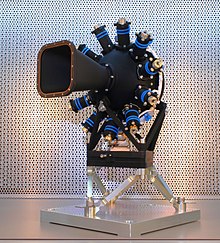NIRSpec
[2] The JWST is the follow-on mission to the Hubble Space Telescope (HST) and is developed to receive more information about the origins of the universe by observing infrared light from the first stars and galaxies.
In comparison to HST, its instruments will allow looking further back in time and will study the so-called Dark Ages during which the universe was opaque, about 150 to 800 million years after the Big Bang.
The NIRSpec instrument is a multi-object spectrograph and is capable of simultaneously measuring the near-infrared spectrum of up to 100 objects like stars or galaxies with low, medium and high spectral resolutions.
The optical path is represented by the following silicon carbide mirror assemblies: In order to achieve the scientific objectives NIRSpec has four operational modes:[3] Multi-Object Spectroscopy (MOS) In MOS the total instrument field of view of 3 × 3 arcminutes is covered using 4 arrays of programmable slit masks.
This allows to obtain spatially resolved spectra of large scenes and can be used to measure the motion speed and direction within an extended object.
NIRSpec has been built by Astrium Germany with subcontractors and partners spread over Europe and with the contribution of NASA from the US which provided the Detector Subsystem and the Micro-shutter Assembly.



